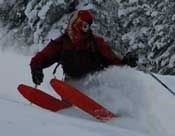Hey Mike,I’d say you should try some targeted experiments with your sidewall materials and your processes to see if you can find where you’re going wrong. Not in a whole board… just small sample preparations and layups until you find the problem.
I was hoping you'd post a comment. I thought it looked like you were using UHMW sidewalls, and I knew that you wouldn't do anything that wasn't top notch. I think your comment above is the very important for anyone who is trying to build consistently good boards or skis. Because I got one bad batch of hardener a few months ago, I now do a test sample of each new batch of epoxy that I get. I also test each new batch of Crown material, and I periodically test a piece of base material from a roll that has been laying around for awhile, just to make sure that the surface treatment hasn't degraded too much over time. Knowing that my raw materials are as they should be helps to reduce the variables, should I encounter some new problem with a lay-up.
You and others have made some good points, particularly regarding the abrading process. I was using 40 grit and sanding until I got a surface that looked like the abraded surface that is present on the material that comes from Crown... or maybe even more rough than Crown's. Doug also indicated that he "sanded these things for an hour". The link that I posted last night suggested that abrading to any degree prior to flame treating may, in fact, decrease bond strength. I hadn't seen that before, after literally hundreds of hours of research. Sounds like the perfect subject for a targeted experiment using three different surface preparations... one not abraded at all, one only slightly abraded, and one aggressively abraded... all variations done on a 12 inch long by 4 inch wide sample, with a 4 inch section of the sample prepped with each variation. Then, flame treat the entire 12 inch section as a whole, lay it up, press it, cure it, and cut the test strip into three 4 inch sections and then see what it takes to get each of the samples to delaminate.
Your thoughts on using MEK are also interesting. I've always used acetone to clean the base material before lay-up, and I've beat my skis on the asphalt pavement and run over them with the car dozens of times trying to get them to delaminate, and the base bond has always been really solid, so I think acetone is okay, but I've never used MEK. It sure would be interesting to get a skibuilders.com interview with the surface treatment head guy at Crown... wasn't that in the works at some point a couple of years ago? If ski and snowboard builders are buying Crown's 1/2 inch UHMW to use as sidewall material, you'd think that Crown would have an interest in trying to assure that we're all having success with using their material.
Okay Doug, if Doughboy and Mike are having such good (and consistent) results using UHMW for sidewalls, and they're flame treating by hand-held propane torch, we should all pay close attention to what thoughts and experience they have to share. I won't do the test I described above because I'm going in a different direction at this time, but a similar test seems, as Mike indicated, to be the key to working out this UHMW sidewall thing.
G-man



